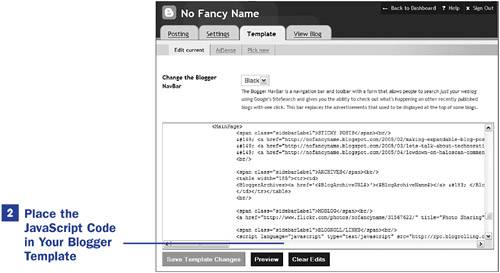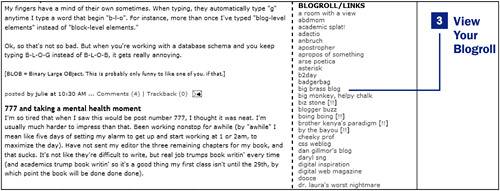Section 42. Using Blogrolls
42. Using Blogrolls
29 Understanding the Blogger Template Structure and Editor 32 Understanding the Blogger Template Language A blogroll is nothing more than a list of blogs (or other websites) you read frequently; it is typically listed in the sidebar of your blog. By listing links to those sites, you associate yourself with the content produced by other bloggers, thereby helping your readers formulate a better picture of who you are. For instance, my personal blogroll currently lists approximately 100 blogs I read on a regular basis. These blogs run the gamut from "life blogs" to "academic" blogs to "geeky" blogs and everything in between, showing that I have a wide range of interests. One hundred links is a lot of links to maintain statically; that is, by placing the HTML code for these links directly into my Blogger template. Because I find new blogs to add to my blogroll on an almost daily basis, that would be a lot of template editing and republishing. This is where blogroll services enter into the mix. A blogroll service provides an interface for you to store the names and URLs of blogs or other websites you read, allows you to customize the appearance of these links in some way, and also provides you with a bit of JavaScript to include in your Blogger template that will result in your blogroll being published on your blog. 42. Using Blogrolls   
Blogroll services typically output your blogroll in several different formats. Some of those formats require additional server-side programming that is not available to you as a Blogger user since you do not have access to the underlying server that creates the static pages making up your blog. Therefore, this topic focuses on the client-side inclusion of content in your blog. The following example of maintaining a blogroll and implementing it on your blog uses the services of BlogRolling.com. However, there are other blogroll services that allow you to save a list of links and publish it to your site with various degrees of customization. The interfaces for these sites vary in their ease of use and the latency between the content request and display. For example, blo.gs is another blogrolling service, backed by Yahoo! and found at http://www.blo.gs/. This free service offers a unique method for finding new blogs and adding them to your blogroll in addition to the standard client-side inclusion via JavaScript. However, the current methods of customization for blo.gs-based blogrolls are lacking for users without knowledge of XML formatting and the ability to produce their own server-side scripts.
The Bloglines World Wide Webbased RSS reader, which you'll learn about in 50 Using an RSS Aggregator, also provides tools to export your list of feed subscriptions as a blogroll for inclusion in your Blogger template. To get started with the BlogRolling.com service, go to http://www.blogrolling.com/ and register for a free account. After registering or logging in to the service, click the Home link in the navigation area. You will see your personal control panel, containing numerous items to assist you in maintaining your blogroll. Click the Add Links link in your control panel to begin adding links to your blogroll. You must know the title and URL of the website or blog that you want to add to your blogroll. In addition to adding links, you can follow the Preferences link to customize certain aspects of your blogroll. For instance, one of my favorite aspects of the BlogRolling.com service is the ability to add an indicator next to the name of any blog that has been updated within a certain timeframe. As you can see in step 3, my personal blogroll has the [!!] characters appended to the end of the names of recently updated blogs. Other users append asterisks (*) or the word fresh!, and so onthe indicator you use is your choice, as is the "freshness" timeframe. The next steps assume that you have registered with BlogRolling.com, added links to your blogroll, and are ready to include these links on your blog. Log in to BlogRolling.com if you are not already, click the Home link, and click the Get Code link in your control panel.
|
EAN: 2147483647
Pages: 124
 BEFORE YOU BEGIN
BEFORE YOU BEGIN NOTE
NOTE